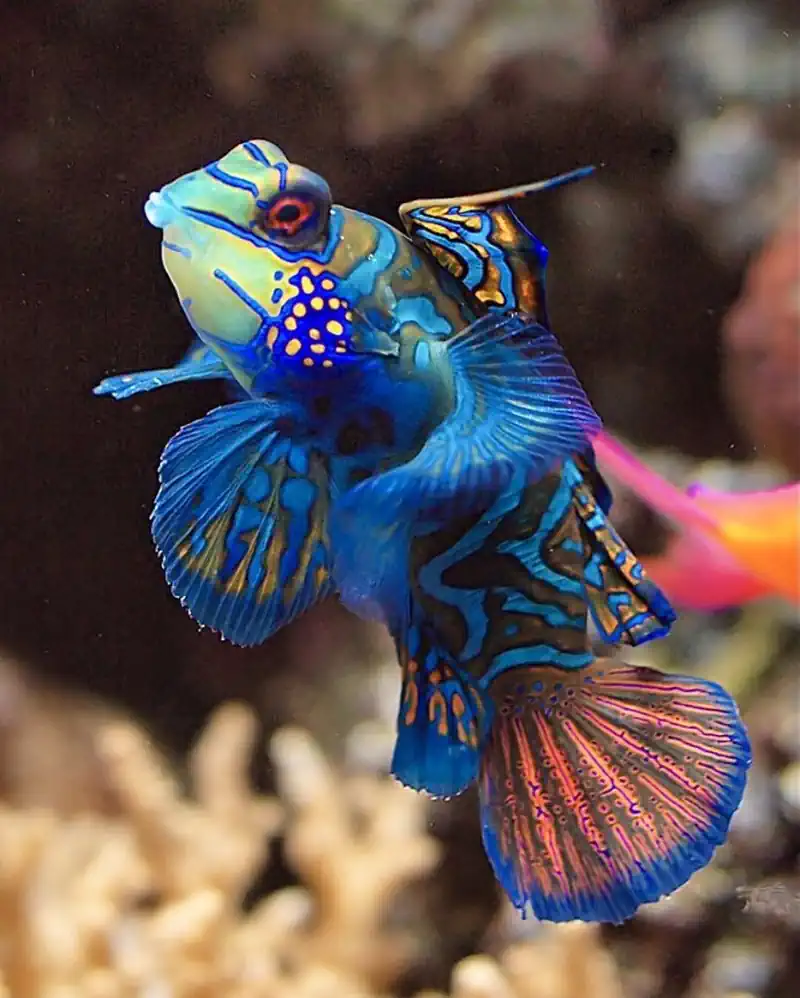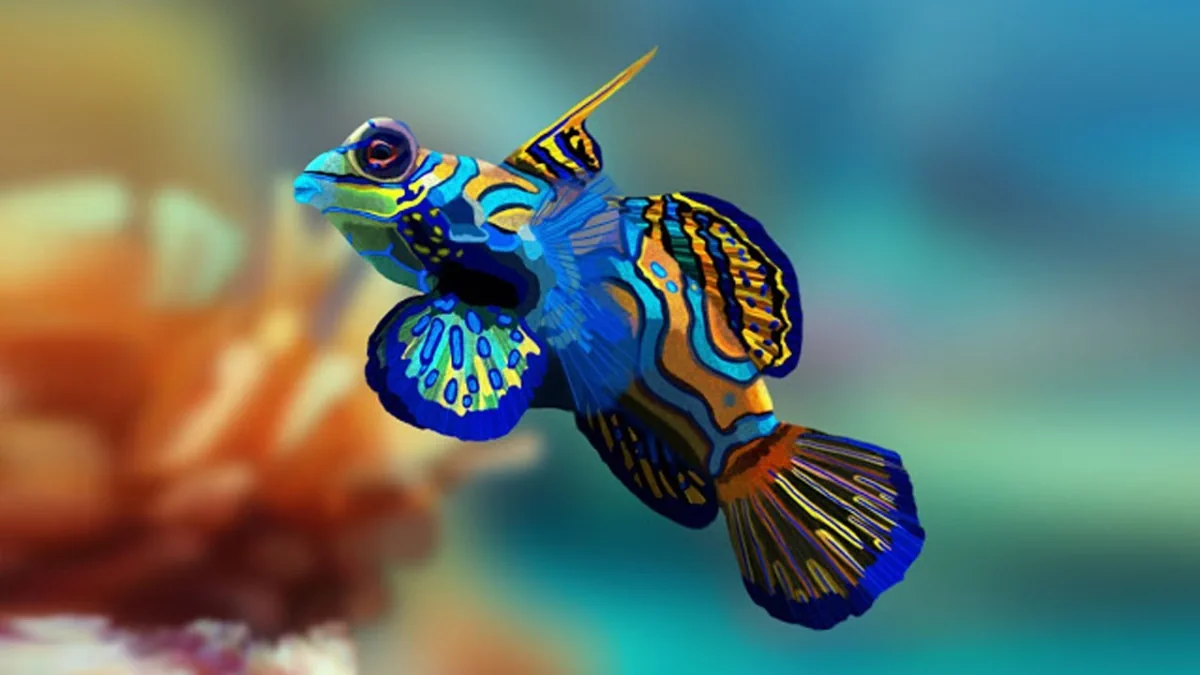Fish Yefdw – If you’ve ever seen a mandarin fish swimming among the colorful corals, you know why they are considered some of the most beautiful fish in the world. With their psychedelic patterns of blue, orange, and green, mandarin fish look like they swam out of a trippy dream. But these little reef dwellers are more than just a pretty face.
Mandarin fish (Synchiropus splendidus), also known as mandarin dragonets, are actually quite fascinating creatures with some unique behaviors and traits. In this article, we’ll dive deep into the world of mandarin fish and explore what makes them so special. Get ready for a kaleidoscopic journey under the sea!
What Do Mandarin Fish Look Like?
One look at a mandarin fish and you’ll understand their appeal. Their bodies are covered in intricate designs of swirling blue and orange. Some varieties have green markings as well. The patterns are so vivid and complex, it’s hard to believe they are real!
Mandarin fish have an elongated body shape, with fan-like pelvic fins they use to “walk” along the reef. Unlike most fish, they don’t have scales. Instead, their skin is coated in a thick, smelly mucus that helps protect them from parasites and predators.
Males and females look a bit different. Males are larger, growing up to 3 inches long, and have an extra long dorsal fin. This impressive fin display is used to attract females during mating.
Where Do Mandarin Fish Live?

Mandarin fish are found in coral reefs throughout the western Pacific ocean, from the Ryukyu Islands down to Australia. They prefer sheltered lagoons and inshore reefs with plenty of places to hide.
During the day, mandarin fish lay low in the reef, tucked between branches of staghorn coral or nestled in crevices. They are most active at dusk, when they emerge to feed and perform their famous mating ritual.
Mandarin Fish Tank Setup
Many people are captivated by the beauty of mandarin fish and want to keep them in a home aquarium. However, they are notoriously difficult to care for in captivity.
Mandarin fish have very specific feeding requirements that are hard to replicate in an aquarium setting. They need a constant supply of live copepods, amphipods, and other small invertebrates to graze on. Most mandarin fish will refuse to eat dried foods or even frozen foods.
If you do want to keep a mandarin fish, you’ll need a well-established tank with plenty of mature live rock for the fish to hunt on. Mandarin fish do best in tanks 30 gallons or larger. It’s also important to keep only one mandarin dragonet per tank, unless you have a mated pair.
What Do Mandarin Fish Eat?
In the wild, mandarin fish are constantly pecking at the reef and substrate, searching for their next meal. They have tiny mouths, so their food has to be very small. The bulk of a mandarin fish’s diet is made up of tiny crustaceans like copepods, amphipods, and isopods. They will also eat small worms, snails, and other invertebrates.
One of the reasons mandarin fish are so difficult to keep in aquariums is that they need to eat constantly. In the wild, they graze on pods and other microfauna all day long. It’s very difficult to provide that level of live food in a tank setting.
Some aquacultured mandarin fish are trained to accept frozen foods and pellets. But for the most part, if you want to keep a mandarin fish, you need to be prepared to culture your own live copepods and other pod species.
Mating Ritual
The mating ritual of mandarin fish is a spectacular sight. Every evening at dusk, mandarin fish gather in groups at the edge of the reef to spawn.
Females seek out a male to mate with. Males put on an elaborate courtship display, flaring their fins and dancing around the female. If a female is interested, she will join in the dance, linking up with the male.
The pair will then begin a slow, spiraling swim upwards in the water column. At the peak of their ascent, the female will release a cloud of eggs and the male will fertilize them. Then the two fish quickly dart back down to the safety of the reef.
This mating dance is repeated every night during breeding season. Females will mate with several males over the course of an evening. After the eggs are fertilized, they are carried away by the currents. The parents provide no additional care.
Breeding in Captivity
Breeding mandarin fish in captivity is extremely difficult. It has only been accomplished a handful of times. The key is having a very large tank with a well-established population of copepods and other pods for the fry to feed on.
Mandarin fish are pelagic spawners, meaning they release their eggs and sperm into the water column. In an aquarium setting, the eggs and fry are quickly sucked into the filtration system.
The fry are also extremely small and have very specific dietary requirements. They need a constant supply of live rotifers and copepod nauplii to survive. These live foods are difficult and expensive to culture at the scale needed to raise mandarin fish fry.
Predators and Threats
Mandarin fish are not an easy meal for predators. Their foul-tasting mucus coating makes them unpalatable to most fish. The bright coloration of mandarin fish also serves as a warning to potential predators that they are toxic.
The biggest threat to mandarin fish is humans. They are frequently collected for the aquarium trade. Many mandarin fish die during collection or shortly after being introduced to an aquarium setting.
Climate change and habitat loss also pose a threat to mandarin fish populations. As coral reefs degrade, mandarin fish lose the shelter and food sources they need to survive.
Conservation
Mandarin fish are not currently considered threatened or endangered. However, their populations are likely declining due to collection for the aquarium trade and loss of coral reef habitat.
The best way to protect mandarin fish is to preserve the coral reefs where they live. This means reducing greenhouse gas emissions to slow climate change and establishing marine protected areas to prevent overfishing and destructive fishing practices.
As an aquarium hobbyist, you can help protect mandarin fish by only buying captive-bred specimens. Captive-bred mandarin fish are more sustainable and better adapted to life in an aquarium.
Conclusion
Mandarin fish are one of the most enchanting creatures on the coral reef. With their dazzling colors and fascinating behaviors, it’s no wonder they are so popular in the aquarium trade.
However, keeping mandarin fish in captivity is not for everyone. They have very specific feeding requirements that are difficult to meet in an aquarium setting.
If you do decide to keep a mandarin fish, make sure you have a large, well-established tank with plenty of live rock and a healthy population of copepods. And always choose a captive-bred specimen over a wild-caught one.
By learning more about these psychedelic beauties and supporting conservation efforts, we can ensure that mandarin fish continue to brighten up the coral reefs for generations to come.






Leave a Comment